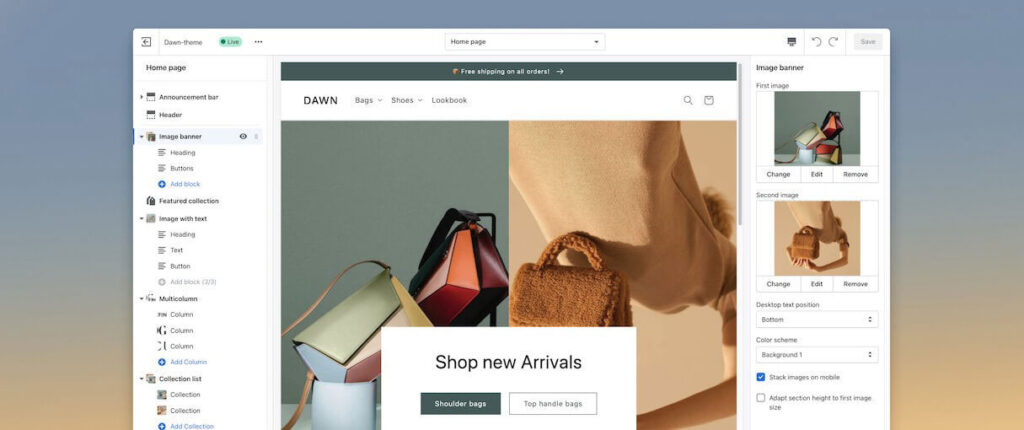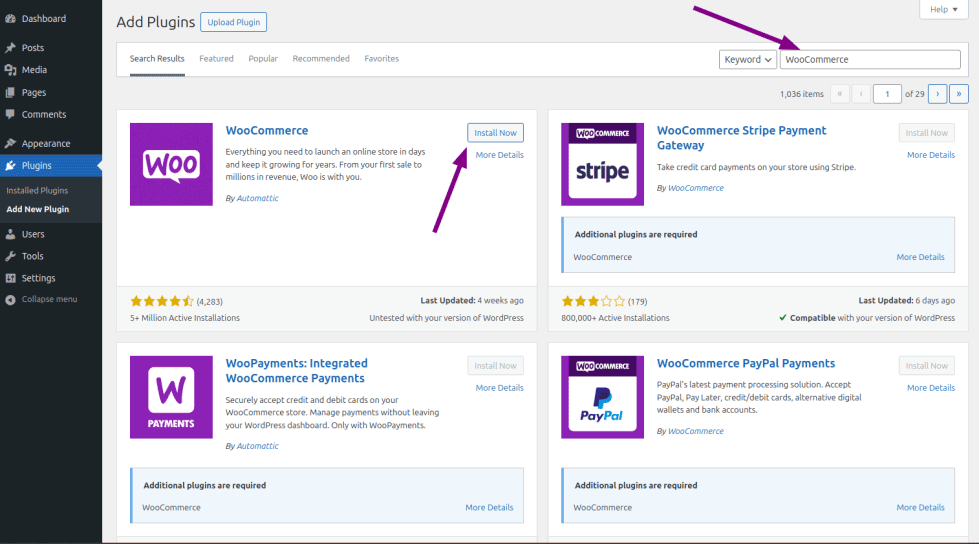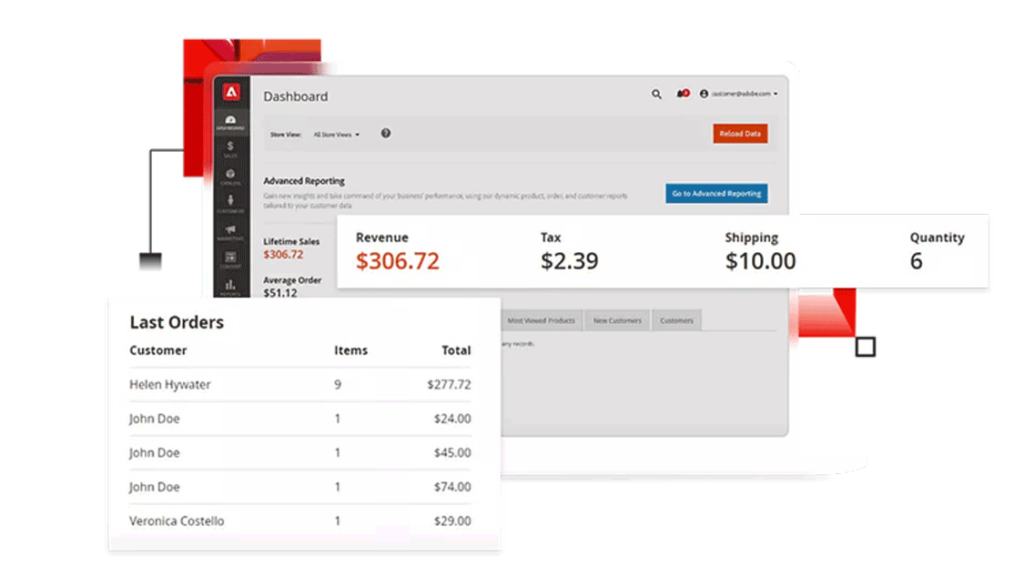Table of Contents
Introduction
Dreaming of launching an online store but hate the idea of managing inventory? Dropshipping can be your ticket to ecommerce freedom! But with a ton of platforms out there, choosing the right one can feel overwhelming. Stop stressing and start selling! Let’s dive into the best ecommerce platforms for dropshipping so you can find the perfect fit to turn your product ideas into profit-generating reality.
1. Wix.com
2. Squarespace
3. Shopify
4. WordPress.com
5. BigCommerce
6. WooCommerce
7. Magento
Overview of Best Ecommerce Platforms For Dropshipping
How to Choose the Best Ecommerce Platforms For Dropshipping
Pros and Cons of Best Ecommerce Platforms For Dropshipping
What to Watch Out For
Pro Tips
Recap
1. Wix.com

Wix is a website builder that lets you create professional-looking websites with a drag-and-drop interface, even if you don’t know how to code. It’s great for beginners and offers features for more complex sites too.
- • Intuitive drag-and-drop interface.
- • Large collection of attractive templates.
- • Extensive app market to extend site features.
- • Good customer support and help resources.
- • Limited customization for more advanced users.
- • Slower load times compared to other platforms.
- • Cloud-Based Platform: Accessible from any device with a browser.
- • Templates: Hundreds of professional templates for various business needs.
- • Drag-and-Drop Editor: Intuitive website building without coding.
- • AI Design Features: Smart customization options for a unique look.
- • Hosting Included: Reliable and secure hosting is part of the service.
- • SEO Tools: Advanced SEO features to improve your site’s visibility.
- • App Market: Add-ons for enhancing functionality and integration.
2. Squarespace

Squarespace is a website builder offering elegant templates, e-commerce features, blogging, analytics, marketing tools, appointment scheduling, and image management for a professional online presence.
- • Beautiful, designer-quality templates.
- • Effective SEO tools for better search rankings.
- • User-friendly interface for easy website creation.
- • Broad selection of themes for various needs.
- • Limited customization options can be restrictive.
- • Expensive costs can escalate with added features.
- • Incomplete e-commerce features.
- • Exquisite Design Choices: A curated collection of sophisticated template designs.
- • Online Store Capabilities: A full suite of e-commerce functionalities, including transaction and payment processes.
- • Content Publishing: Advanced options for creating and managing blog content.
- • Performance Insights: In-depth analytics for monitoring website activity.
- • Promotional Tools: Capabilities for email campaigns and access to specialized services.
- • Scheduling Solutions: Efficient systems for booking and organizing appointments.
- • Visual Asset Handling: An intuitive interface for adding and editing images with ease.
3. Shopify

Shopify lets you set up your own online store, with tools to add products, handle payments, and track sales. Think of user-friendly shop windows for your brand.
- • Offers a wide range of professional, responsive themes that can be customized to fit the branding needs of different businesses.
- • Provides different pricing plans and features that cater to businesses of all sizes.
- • Has a vast app store with thousands of apps and plugins that can extend the functionality of your store.
- • Offers robust security features, including SSL certification and compliance with PCI standards, ensuring that customer data is protected.
- • Incurs transaction fees if not using Shopify Payments.
- • Faces limited free themes and high costs for paid ones.
- • Deals with coding limitations due to Shopify’s Liquid language.
- • Works with a limited blogging interface compared to dedicated services.
- • Online Store Customization: Utilize themes and an intuitive editor to design your storefront.
- • Multi-Channel Selling: Connect and sell on various platforms like Facebook, Instagram, and Amazon.
- • Product Management: Add products, set prices, and track inventory with ease.
- • Payment Processing: Accept payments through various methods including credit cards and PayPal.
- • Shipping Solutions: Set up shipping rates and integrate with major carriers for label printing and tracking.
- • Marketing Tools: Access SEO features, create discount codes, and use analytics to track performance.
4. WordPress.com

Choose WordPress.com for its user-friendly interface, extensive customization options, and robust community support. Ideal for beginners and professionals seeking a reliable web publishing platform.
- • Offers an easy-to-use platform for building websites without needing coding skills, making it accessible to beginners.
- • Provide a wide range of themes to suit different types of websites, from blogs to business sites, which can be customized to fit your branding.
- • Handles all the technical aspects of website maintenance, including updates, backups, and security, freeing users from these responsibilities.
- • Provides built-in tools for search engine optimization and marketing, helping to improve website visibility and engagement.
- • Includes reliable hosting services, ensuring that websites have minimal downtime and fast loading speeds.
- • Charges for many advanced features, including custom domain names, premium themes, and additional storage.
- • Displays ads on websites using the free plan, which can be distracting to visitors and detract from the site’s professionalism.
- • Comes with limitations on storage and bandwidth, which may not be sufficient for large or high-traffic websites.
- • Incur costs for additional features, themes, and upgrades, which can add up over time.
- • Themes: Hundreds of free and premium themes for site customization.
- • Plugins: Add features with third-party plugins.
- • User Management: Control access and roles for different users.
- • SEO Tools: Optimize your site for search engines.
- • Analytics: Track site performance and visitor statistics.
- • Mobile-Friendly: Create and manage your site on any device.
5. BigCommerce

BigCommerce is an e-commerce platform offering extensive features for online stores, including customizable templates, payment integration, and scalable solutions for businesses of all sizes.
- • Offers an all-in-one e-commerce platform.
- • Charges no transaction fees.
- • Provides excellent customer support.
- • Includes a wide range of templates and design options.
- • Supports multiple inventory locations.
- • Presents higher pricing compared to some competitors.
- • Imposes bandwidth limits on plans.
- • Limits third-party integrations.
- • Requires additional costs for certain features.
- • Lacks a free plan for small-scale sellers.
- • Template Library: A wide range of e-commerce templates for various industries.
- • Drag-and-Drop Site Editor: Easy customization without coding.
- • Sales Channels: Sell across multiple platforms like Amazon, eBay, and social media.
- • Product Reviews: Feature customer feedback on products.
- • Inventory Management: Track and manage stock levels efficiently.
PRO TIPS >>> Is Shopify the Best Ecommerce Platform?
6. WooCommerce

WooCommerce is a customizable, open-source eCommerce platform built on WordPress for small to large-sized online merchants.
- • Offers a user-friendly interface.
- • Provides flexibility with an open-source nature.
- • Supports a vast array of plugins.
- • Enables easy management of products and orders.
- • Integrates well with other services and platforms.
- • Requires some technical skills for setup.
- • Needs good hosting for optimal performance.
- • Experiences compatibility issues with some plugins.
- • Demands regular updates for security and features.
- • Flexibility: Offers a range of product types, including physical, digital, and affiliate products.
- • Customization: Access to hundreds of free and premium WordPress themes and the ability to modify CSS and create custom templates.
- • Payment Options: Supports multiple payment gateways like PayPal, credit cards, and bank transfers.
- • Shipping Options: Configurable shipping options including flat rates, free shipping, and real-time calculations.
- • Inventory Management: Tools to manage your stock levels, backorders, and hide out-of-stock items.
- • Tax Options: Automated tax calculations, geo-location tax rates, and custom tax rates.
- • Analytics: Built-in analytics for sales, orders, and customer statistics.
7. Magento

Magento is an open-source e-commerce platform offering powerful analytics, inventory management, and customization options for scalable online stores.
- • Offers extensive customization options.
- • Provides robust scalability for growing businesses.
- • Supports a large community of developers.
- • Includes powerful marketing, SEO, and catalog-management tools.
- • Facilitates multi-store and multi-language support.
- • Requires significant resources and hosting specifications.
- • Demands development expertise for customization.
- • Involves a complex and time-consuming setup process.
- • Incurs higher costs due to development and maintenance.
- • Presents a steep learning curve for new users.
- • Customization: Extensive theming and customization options.
- • Product Management: Advanced product management capabilities, including batch imports and exports.
- • Customer Segmentation: Tools to target customers based on their shopping cart and buying history.
- • SEO Optimization: SEO-friendly features like URL rewrites and meta-information management.
- • Marketing Tools: Promotions, coupons, and email marketing integration.
- • Analytics and Reporting: Detailed reports on sales, customers, and inventory.
- • Checkout, Payment, and Shipping: Secure checkout, multiple payment gateways, and shipping options.
Overview of Best Ecommerce Platforms For Dropshipping

Looking to start dropshipping? Here’s a quick guide to the best eCommerce platforms. Wix.com is perfect for beginners, offering an easy-to-use drag-and-drop interface with customizable templates. Squarespace is stylish and design-focused, great for creating visually appealing online stores. Shopify stands as the gold standard for dropshipping, known for its user-friendly experience, extensive app integrations, and scalability. WordPress.com is ideal for bloggers-turned-sellers, allowing you to use plugins to expand functionality.
BigCommerce is robust and scalable, providing advanced features and seamless integration with other tools. WooCommerce, a WordPress plugin, is highly flexible and perfect for those who want complete control. Magento is best for large businesses, offering high customizability but requiring technical expertise. Choose the one that fits your needs and start your dropshipping journey!
How to Choose the Best Ecommerce Platforms For Dropshipping
Choosing the best eCommerce platform for dropshipping requires a few key steps. First, assess your technical skills. If you’re a beginner, opt for user-friendly platforms like Wix or Shopify. Consider your budget—Shopify offers great features but can be pricier, while WooCommerce is cost-effective but requires WordPress.
Think about scalability. If you plan to grow, platforms like BigCommerce or Magento offer robust solutions. Evaluate design needs—Squarespace excels in aesthetics, perfect for showcasing products beautifully. Check for integrations. Platforms like Shopify and BigCommerce provide extensive app integrations essential for dropshipping. Lastly, read reviews and test out demos to see which interface you prefer. Follow these steps, and you’ll find the perfect platform for your dropshipping business!
GET SMARTER >>> Wix eCommerce Platform Review
Pros and Cons of Best Ecommerce Platforms For Dropshipping
Pros
- Offers a variety of customization options, allowing businesses to tailor their store to their brand and customer needs.
- Provides access to a vast range of integrations and apps, enhancing functionality and improving user experience.
- Supports scalability, accommodating growth as businesses expand and traffic increases.
- Includes user-friendly interfaces, making it easy for beginners to set up and manage their online stores.
- Enables efficient inventory management and order processing through automation, saving time and reducing errors.
Cons
- Imposes ongoing costs, including subscription fees and potential additional charges for premium features or integrations.
- Requires some level of technical knowledge or support, especially for more advanced customization and maintenance.
- Limits SEO and performance optimization capabilities on certain platforms, affecting visibility and site speed.
- Demands regular updates and security measures to protect against vulnerabilities and ensure smooth operation.
- Poses challenges when migrating to a different platform, including data transfer issues and potential downtime.
What to Watch Out For…

When choosing an ecommerce platform for dropshipping, prioritize flexibility and scalability. Ensure the platform supports easy integration with your suppliers and offers robust inventory management. Watch out for hidden fees and high transaction costs that can eat into your profits. Pay attention to SEO capabilities to ensure your store is easily discoverable.
Evaluate the platform’s customer support quality and accessibility, as you’ll need prompt assistance when issues arise. Then, check for customization options to ensure your store can grow and adapt as your business evolves. Choose a platform that aligns with your long-term business goals and technical comfort level.
Pro Tips
- Make sure the platform easily integrates with your dropshipping suppliers to streamline inventory and order management.
- Choose a platform that can grow with your business, handling increased traffic and expanding product lines without compromising performance.
- Look out for transaction fees, app costs, and other hidden charges that could cut into your profits.
- Ensure the platform offers a user-friendly interface for both you and your customers, simplifying store management and enhancing shopping experiences.
- Select a platform with strong SEO tools to help your store rank higher in search engine results and attract more organic traffic.
- Opt for a platform with reliable and accessible customer support to quickly resolve any issues that arise.
- Ensure the platform allows for easy customization to match your brand’s unique look and feel.
- Confirm that the platform supports mobile-friendly designs, as a significant portion of online shopping occurs on mobile devices.
Recap
When it comes to dropshipping, several ecommerce platforms stand out. Shopify offers a user-friendly interface and an extensive app store for seamless business management. WooCommerce is known for its flexibility and customizability, making it ideal for tech-savvy entrepreneurs.
BigCommerce boasts robust features and built-in marketing tools to boost online sales. Squarespace stands out for its stunning website templates and easy-to-use platform. Meanwhile, Wix offers drag-and-drop functionality and affordable pricing plans. With these top platforms, entrepreneurs can kickstart their dropshipping business and thrive in the competitive ecommerce landscape.







